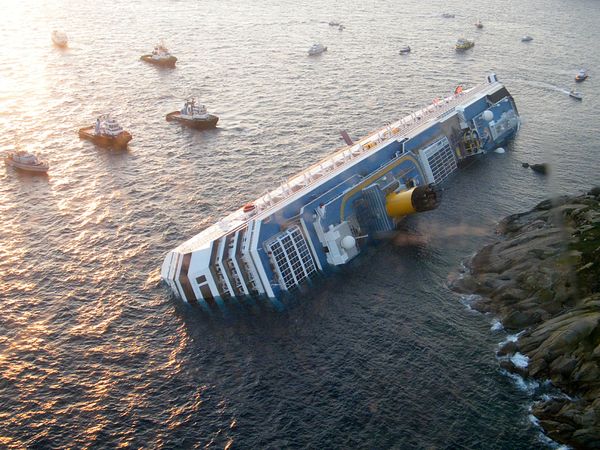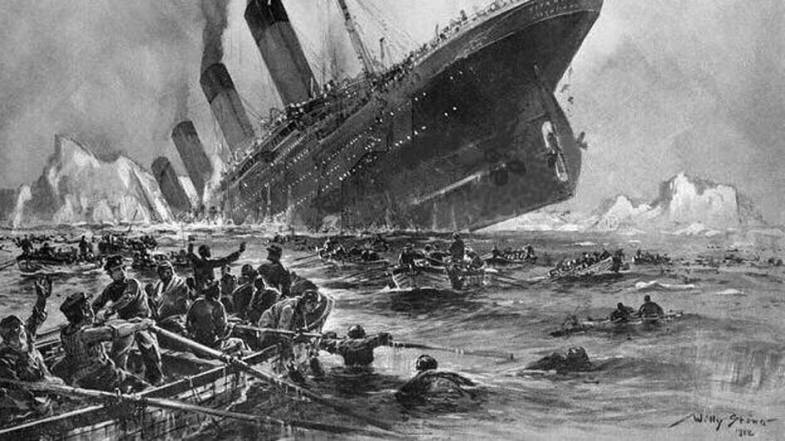100 years of disaster relationship… (Titanic to Costa Concordia)
Published in Sagar Sandesh Maritime Weekly’s Dec 12 edition
Source:http://www.sagarsandesh.com/epaper/
-Whereas the Titanic collided with an iceberg, the Costa Concordia hit an underwater rock
-Trust in technology may in both cases have affected the attitude of the navigators of such ships
By Capt S Bhardwaj
PIC courtesy: http://www.cam.ac.uk/research/discussion/women-and-children-first/attachment/120119-titanic-sinking/
Titanic was supposed to be the ‘unsinkable’ then; Costa Concordia was also a masterpiece of modern technology. Despite more than 100 years of regulatory and technological progress in maritime safety, accidents do occur.
Both the cases involved state-of-the-art cruise ships – although the same state and the stage have obviously changed dramatically in the 100 years in between.
Whereas the Titanic collided with an iceberg, the Costa Concordia hit an underwater rock. In both the incidents the ships were subjected to an unexpected and massive flooding.
While the maritime technology has changed beyond recognition between 1912 and 2012, human factors and organizational factors have not.
Organizations have, of course, changed in the way they carry out their work, due to increased horizontal and vertical integration made possible by ubiquitous information technology.
But the thinking and attitudes of management have changed less and may possibly not have changed at all, at least when it comes to such issues as risk taking and prioritization of issues relating to operational safety.
The purpose is rather to show that accidents still happen for the same underlying human and organizational reasons, despite the technological progress in the past 100 years and despite all safety regulations and precautions. It is remarkable that certain underlying conditions are still the same today as at the time of the Titanic.
It is even more remarkable – and worse, regrettable – that the accident investigations and the reactions to accidents more or less are the same now as they were 100 years ago.
Authority gradient and its influence on communication
The term “authority gradient” refers to the distribution of decision-making and the balance, or imbalance, of authority and power in a group or organization, usually in relation to a specific type of situation. Although it is rarely considered by the maritime industry, it plays an important role in, e.g., health care or aviation. It is used to describe how easy or difficult it may be for someone with a lower authority to question or challenge somebody with a higher authority. The authority gradient is itself influenced by a number of other factors, such as education, social background, gender, age, professional roles and perceived expertise.
Cognitive hysteresis – resistance to revising a situation assessment
The term cognitive hysteresis – or psychological fixation – describes the situation where people fail to revise their initial assessments in response to new evidence, particularly evidence that diverges from the expected (Woods et al. 2010). While the initial situation assessment may have been appropriate at the time it was made, the cognitive hysteresis means that neither the assessment nor the chosen course of action is revised even if an opportunity for that arises.
A similar case of the Titanic or the Costa Concordia may have contributed to a situation where the masters held on to an imprecise or incorrect picture of the situation. He might have been so convinced by this wrong mental picture of the situation that it would have required some external questioning by his officers to force him to realize that the situation was different from what he assumed.
Unanticipated consequences of new technology:
Another reason for underestimating risks may be reliance on new technology. The Titanic was considered a masterpiece of naval architecture in 1912. This might have led to the belief that a collision with an iceberg could be survived and that the ship would stay afloat even with severe structural damage to the hull.
In 2012, the Costa Concordia was equipped with significantly better technology. The navigation equipment alone provided an accurate position of the ship at any time on the sea chart and also showed the predicted future positions given the current course and speed.
Trust in technology may in both the cases have affected the attitude of the navigators of such ships.
 PIC Courtesy:http://news.nationalgeographic.com/news/travelnews/2012/01/pictures/120118-travel-costa-concordia/
PIC Courtesy:http://news.nationalgeographic.com/news/travelnews/2012/01/pictures/120118-travel-costa-concordia/
Organizational influences (latent conditions)
Today ISM gives “overriding authority” to Master. Even Titanic master received a letter which he had to sign and return. The letter stated that “You are to dismiss all idea of competitive passages with other vessels and to concentrate your attention upon a cautious, prudent and ever watchful system of navigation, which shall lose time or suffer any other temporary inconvenience rather than incur the slightest risk which can be avoided.”
But there was also a conflicting message from management. In the Titanic accident report, Lord Mersey, the Judge heading the investigation, commented “Its root is probably to be found in the competition and in the desire of the public for quick passages rather in the judgement of the navigators”.
A similar dilemma can be found in the case of Costa Concordia, where the company advertised that the ship would sail a “touristy” sailing course close to land. The case is not simply that organizations (the blunt end) give one message – like “safety first” – but neglect to follow-up on it. The case is rather that organizations want to have their cake and eat it too, by emphasizing both safety and productivity. This creates a psychological and social conflict at the sharp end, where the outcome is uncertain.
In shipping operations, as in any other industry, time and resource constraints affect the day-to-day routines. The time and the measures taken to ensure safety operations have to be balanced with economical considerations in the commercial operation of a ship.
The desire to arrive in time with the ship has indeed often played a fatal role in accidents, such as Herald of Free Enterprise in1987 (DoT 1987), Estonia in 1994 (Joint Accident Investigation Commission 1997), the MSC Napoli in 2007 (Marine Accident Investigation Branch 2008) and of course the Titanic.
Maritime accident investigation & persistent human factors issues
Accident investigations very often seem to be constrained by the principles of What-You-Look- For-Is-What-You-Find and What-You-Find-Is-What-You-Fix Maritime accident investigations have traditionally looked for one or more distinct causes and tried to address them one by one, as if they were independent of each other. The near universal assumption, expressed by the causality credo, is that every effect has a cause, and that the cause usually can be determined to be a failure or malfunction of a “component” – be it technological, human or organizational.
According to this logic, if we can find and fix the failure or the malfunction, then the risk will be reduced or even eliminated and safety therefore increased.
The causality credo, however, limits the scope of investigations to concrete and tangible causes, but neglects a host of other factors that are less conspicuous and have a more indirect influence. As the comparison of the fates that befell the Titanic and the Costa Concordia however shows, accidents seem to happen for the same underlying human and organizational reasons even though they are separated by a century of improvements to technology and safety regulations.
In the wider perspective, the really important question is therefore not why these and many other ships have foundered, but rather why these reasons remain and why accident investigations and the reactions to them are more or less the same now as they were 100 years ago.
One explanation is that safety thinking that focuses on things that go wrong or could go wrong, such as near misses, incidents and accidents.
The alternative perspective, called Safety-II, focuses on the situations of everyday work where things go right. In this case the purpose of safety efforts is to facilitate the performance adjustments that are necessary for everyday work to succeed, i.e., not only try to avoid things going wrong, but also try to ensure that they go right.
This cannot be done without understanding how things happen, including the many human and organizational factors that determine how work is carried out, for example the authority gradient, group think, cognitive hysteresis, unanticipated consequences of new technology, latent organizational conditions, and the ubiquitous trade-offs between efficiency and thoroughness.
If no one is looking for the human and organizational factors described in this write-up, no one will find them. And if no one finds them, no one will do anything about them. Yet investigations of accidents in today’s complex work environments cannot afford to look only at “component” malfunctions and failures. Actual safety improvements will not occur until we understand how functions depend on each other and at how seemingly subtle changes and performance variability can lead to out-of-scale outcomes.
Acknowledgements:
Jens-Uwe Schröder-Hinrichs & Michael Baldauf (Maritime Risk and Safety (MaRiSa) Research Group, World Maritime University)
E. Hollnagel, University of Southern Denmark, Odense, Denmark.
The similarities
– Both the masters were very experienced and had immaculate service records prior to the accidents. They had spent their entire professional life at sea without larger accidents.
– Both of them were aware of the potential dangers, but felt that the risks were so small that they could easily be controlled.
– In the case of the Titanic, no officer on the bridge objected to the navigation of the ship. So far, no information has been published to show that officers on the Costa Concordia disagreed with the manoeuvres of the master.
– In both the incidents, the shipping companies (White Star Line and Costa Crociere respectively) either tacitly approved or even encouraged the masters’ decisions to prioritize performance over safety.
– Both accidents resulted in emergency situations for which the ships were not built (beyond design-base accidents). Both scenarios were also considered as being highly unlikely.
– In both accident scenarios, difficulties during evacuation occurred.
Posted on December 13, 2012, in General. Bookmark the permalink. Leave a comment.

Leave a comment
Comments 0